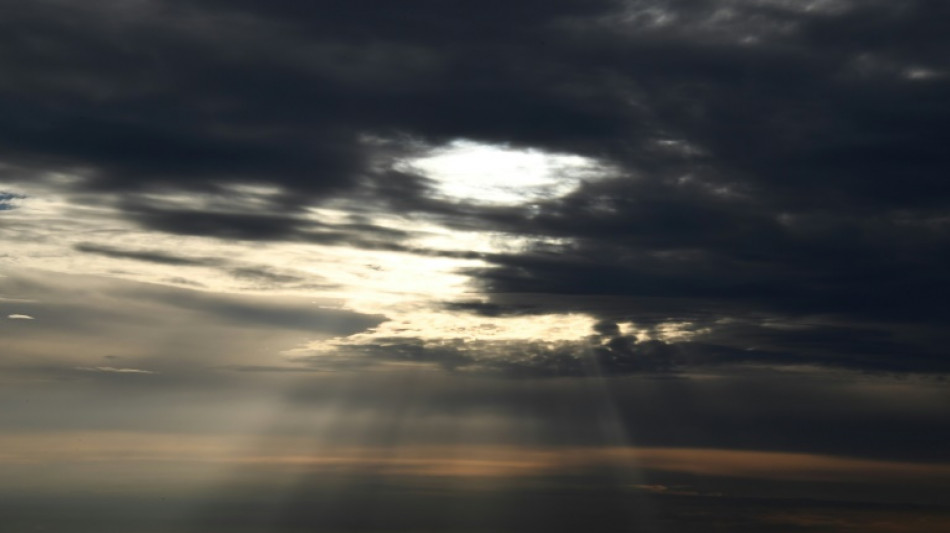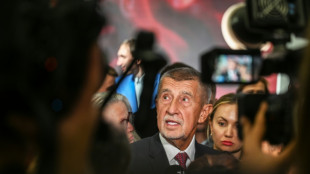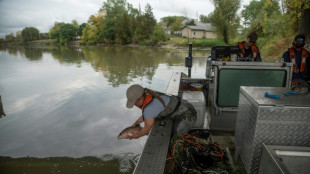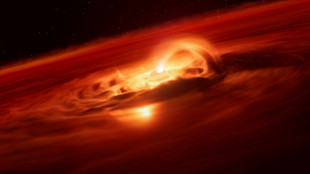
-
 Trump administration declares US cities war zones
Trump administration declares US cities war zones
-
Bad Bunny takes aim at Super Bowl backlash in 'SNL' host gig

-
 El Khannouss fires Stuttgart into Bundesliga top four
El Khannouss fires Stuttgart into Bundesliga top four
-
Insatiable Pogacar romps to European title

-
 Newcastle inflict more pain on Postecoglou, Everton end Palace's unbeaten run
Newcastle inflict more pain on Postecoglou, Everton end Palace's unbeaten run
-
Daryz wins Prix de l'Arc de Triomphe thriller

-
 Russell wins Singapore GP as McLaren seal constructors' title
Russell wins Singapore GP as McLaren seal constructors' title
-
Landslides and floods kill 64 in Nepal, India

-
 Russell wins Singapore GP, McLaren seal constructors' title
Russell wins Singapore GP, McLaren seal constructors' title
-
Djokovic 'hangs by rope' before battling into Shanghai last 16

-
 Erasmus proud of Boks' title triumph as Rugby Championship faces uncertain future
Erasmus proud of Boks' title triumph as Rugby Championship faces uncertain future
-
French PM under pressure to put together cabinet

-
 US Open finalist Anisimova beats Noskova to win Beijing title
US Open finalist Anisimova beats Noskova to win Beijing title
-
Hamas calls for swift hostage-prisoner swap as talks set to begin

-
 Opec+ plus to raise oil production by 137,000 barrels a day in November
Opec+ plus to raise oil production by 137,000 barrels a day in November
-
Death toll from Indonesia school collapse rises to 45

-
 Brisbane Broncos edge Storm in thrilling NRL grand final
Brisbane Broncos edge Storm in thrilling NRL grand final
-
Refreshed Sabalenka 'ready to go' after post-US Open break

-
 Georgia PM vows sweeping crackdown after 'foiled coup'
Georgia PM vows sweeping crackdown after 'foiled coup'
-
Landslides and floods kill 63 in Nepal, India

-
 No handshakes again as India, Pakistan meet at Women's World Cup
No handshakes again as India, Pakistan meet at Women's World Cup
-
Georgia PM announces sweeping crackdown on opposition after 'foiled coup'

-
 Syria selects members of first post-Assad parliament
Syria selects members of first post-Assad parliament
-
Russian strikes kill five in Ukraine, cause power outages

-
 World champion Marquez crashes out of Indonesia MotoGP
World champion Marquez crashes out of Indonesia MotoGP
-
Babis to meet Czech president after party tops parliamentary vote

-
 Death toll from Indonesia school collapse rises to 37
Death toll from Indonesia school collapse rises to 37
-
OPEC+ meets with future oil production hanging in the balance

-
 Dodgers down Phillies on Hernandez homer in MLB playoff series opener
Dodgers down Phillies on Hernandez homer in MLB playoff series opener
-
Philadelphia down NYCFC to clinch MLS Supporters Shield

-
 Syria selects members of first post-Assad parliament in contested process
Syria selects members of first post-Assad parliament in contested process
-
Americans, Canadians unite in battling 'eating machine' carp

-
 Negotiators due in Cairo for Gaza ceasefire, hostage release talks
Negotiators due in Cairo for Gaza ceasefire, hostage release talks
-
Trump authorizes troops to Chicago as judge blocks Portland deployment

-
 Wallabies left ruing missed chances ahead of European tour
Wallabies left ruing missed chances ahead of European tour
-
Higgo stretches PGA Tour lead in Mississippi

-
 Blue Jays pummel Yankees 10-1 in MLB playoff series opener
Blue Jays pummel Yankees 10-1 in MLB playoff series opener
-
Georgia ruling party wins local polls as mass protests flare

-
 Depoortere stakes France claim as Bordeaux-Begles stumble past Lyon
Depoortere stakes France claim as Bordeaux-Begles stumble past Lyon
-
Vinicius double helps Real Madrid beat Villarreal

-
 New museum examines family life of Mexican artist Frida Kahlo
New museum examines family life of Mexican artist Frida Kahlo
-
Piccioli sets new Balenciaga beat, with support from Meghan Markle

-
 Lammens must be ready for 'massive' Man Utd scrutiny, says Amorim
Lammens must be ready for 'massive' Man Utd scrutiny, says Amorim
-
Arteta 'not positive' after Odegaard sets unwanted injury record

-
 Slot struggles to solve Liverpool problems after third successive loss
Slot struggles to solve Liverpool problems after third successive loss
-
Netanyahu hopes to bring Gaza hostages home within days as negotiators head to Cairo

-
 Ex-NFL QB Sanchez in hospital after reported stabbing
Ex-NFL QB Sanchez in hospital after reported stabbing
-
Liverpool lose again at Chelsea, Arsenal go top of Premier League

-
 Liverpool suffer third successive loss as Estevao strikes late for Chelsea
Liverpool suffer third successive loss as Estevao strikes late for Chelsea
-
Diaz dazzles early and Kane strikes again as Bayern beat Frankfurt


Unfinished deepsea observatory spots highest-energy neutrino ever
A neutrino with 30 times more energy than any previously seen on Earth was detected by an unfinished observatory at the bottom of the Mediterranean Sea after travelling from beyond this galaxy, scientists said Wednesday.
Neutrinos are the second most abundant particle in the universe. Known as ghost particles, they have no electric charge, almost no mass and effortlessly pass through most matter -- such as our world or bodies -- without anyone noticing.
The most violently explosive events in the universe -- such as a star going supernova, two neutron stars smashing into each other or the almighty suck of supermassive black holes -- create what is called ultra-high-energy neutrinos.
Because these particles interact so little with matter, they glide easily away from the violence that created them, travelling in a straight line across the universe.
When they finally arrive at Earth, neutrinos serve as "special cosmic messengers" offering a glimpse into the far reaches of the cosmos that is otherwise hidden from our view, Italian researcher Rosa Coniglione said in a statement.
However, these ghost particles are extremely difficult to detect. One way is by using water.
When light passes through water, it slows down. This sometimes allows quick-moving particles to overtake light -- while still not going faster than the speed of light.
When this happens, it creates a bluish glow called "Cherenkov light" that can be detected by extraordinarily sensitive sensors.
But to observe this light requires a huge amount of water -- at least one cubic kilometre, the equivalent of 400,000 Olympic swimming pools.
That is why the Cubic Kilometre Neutrino Telescope, or KM3NeT, lies at the bottom of the Mediterranean.
- Think of a ping pong ball -
The European-led facility is still under construction, and spread over two sites. Its ARCA detector, which is interested in astronomy, is nearly 3,500 metres (2.2 miles) underwater off the coast of Sicily.
The neutrino-hunting ORCA detector is in the depths near the French city of Toulon.
Cables hundreds of metres long equipped with photomultipliers -- which amplify miniscule amounts of light -- have been anchored to the seabed nearby. Eventually 200,000 photomultipliers will be arrayed in the abyss.
But the ARCA detector was operating at just a tenth of what will be its eventual power when it spotted something strange on February 13, 2023, according to new research published in the journal Nature.
A muon, which is a heavy electron produced by a neutrino, "crossed the entire detector, inducing signals in more than one-third of the active sensors," according to a statement from KM3NeT, which brings together 350 scientists from institutions in 21 countries.
The neutrino had an estimated energy of 220 petaelectronvolts -- or 220 million billion electron volts.
A neutrino with such a massive amount of energy had never before been observed on Earth.
"It is roughly the energy of a ping pong ball falling from one metre height," Dutch physicist and KM3NeT researcher Aart Heijboer told a press conference.
"But the amazing thing is that all this energy is contained in one single elementary" particle, he added.
For humans to create such a particle would require building the equivalent of a Large Hadron Collider "all around the Earth at the distance of the geostationary satellites", said French physicist Paschal Coyle.
- Blazars as source? -
With this kind of energy, the event that created this neutrino must have been beyond Milky Way.
The exact distance remains unknown, "but what we are quite sure is that it's not coming from our galaxy", said French physicist Damien Dornic.
The astrophysicists have some theories about what could have caused such a neutrino. Among the suspects are 12 blazars -- the incredibly bright cores of galaxies with supermassive black holes.
But more research is needed.
"At the time this event happened, our neutrino alert system was still in development," Heijboer emphasised.
If another neutrino is detected near the end of this year, an alert will be sent in seconds to "all the telescopes around the world so that they can point in that direction" to try to spot the source, he said.
P.Vogel--VB




